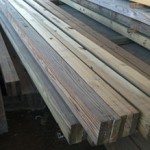We recently had one of our engineers specify the use of glulam pressure treated columns to support one of our custom designed pole buildings. The client was concerned about pressure treated glulams in the ground, so it was time for some heavy duty research.
According to the American Institute of Timber Construction (AITC), structural glued laminated timbers (glulams) can be treated with waterborne preservatives after laminating.
While in general, the laminated timber industry recommends against using waterborne preservative chemicals to pressure treat structural glued laminated timbers after bonding, this recommendation is only intended to prevent appearance problems caused by treatment and subsequent re-drying. Pressure treatment with waterborne chemicals after bonding does not generally make the laminated timber structurally unfit. Treating structural glued laminated timbers (glulams) with waterborne chemicals after bonding may be a viable option for applications where appearance is less critical, like for pole buildings.
 Adhesives used in modern glulams are extremely durable and are considered waterproof. Glulam timbers treated after bonding will accept treatment and resist decay similar to treated sawn timbers of the same species and will perform similarly in service. If the appearance of this product is acceptable to the consumer, it can be used successfully in applications where treated wood is required. Provided the structural requirements of the application are met (meaning – was the right size and grade of pole selected for factors such as wind speed, snow load, etc.), treated glulam timbers can be used in place of treated sawn timbers.
Adhesives used in modern glulams are extremely durable and are considered waterproof. Glulam timbers treated after bonding will accept treatment and resist decay similar to treated sawn timbers of the same species and will perform similarly in service. If the appearance of this product is acceptable to the consumer, it can be used successfully in applications where treated wood is required. Provided the structural requirements of the application are met (meaning – was the right size and grade of pole selected for factors such as wind speed, snow load, etc.), treated glulam timbers can be used in place of treated sawn timbers.
Pressure-treatment is a process of applying preservative chemicals to wood to increase resistance to decay. Pressure-treated wood is used in applications where wood will be wet and subject to decay.
Pressure treatment of properly manufactured structural glued laminated timber members will not cause delamination. Delamination refers to adhesive failure leading to separation of bond lines. Adhesives used in modern glulam products must meet stringent standards for moisture resistance and durability. Additionally, adhesive bonds in glulams must also pass rigorous daily testing for strength and durability. Consequently, delamination is very rare in structural glued laminated timber whether it is pressure-treated after bonding or not. Checks can occur along bond lines due to stress concentrations between laminations and are often mistaken for delamination. The presence of wood fiber separations or torn wood fibers at the bond line is the key distinguishing characteristic of checks .
If glued laminated timbers are treated after bonding, dimensional changes caused by saturation of the wood with the water-borne preservatives and their carrier followed by subsequent re-drying may result in raised grain and warping, checking, or splitting.
Some species do not accept treatment well and require incising while others can be treated successfully without incising. Southern Pine is generally not incised, while Douglas fir typically requires incising for adequate penetration of the preservative.
Bottom line is, can you use glu-lams in the ground for pole buildings if they are pressure treated for in-ground use? Absolutely! The treatment process to get them to the PT level may cause them to look not quite as pretty as the varnished beams in your cathedral ceiling, but they will be every bit as strong. And rest assured…they will not rot. If you don’t believe me – maybe you will believe the American Institute of Timber Construction.






